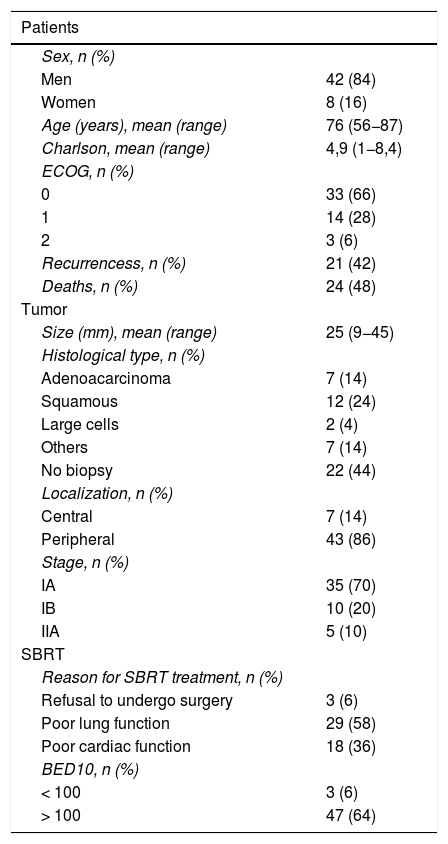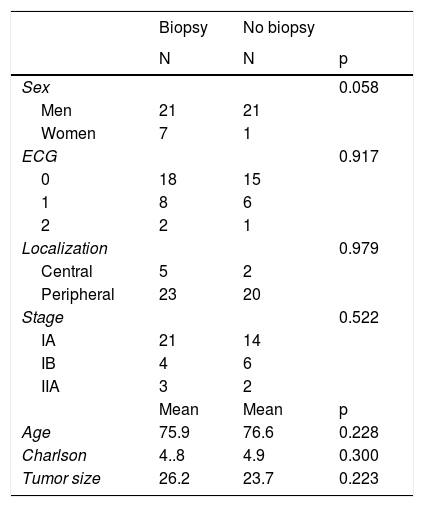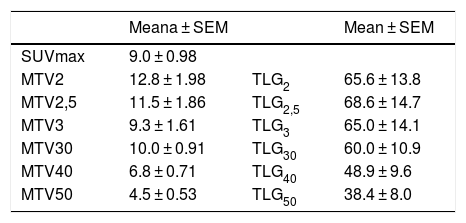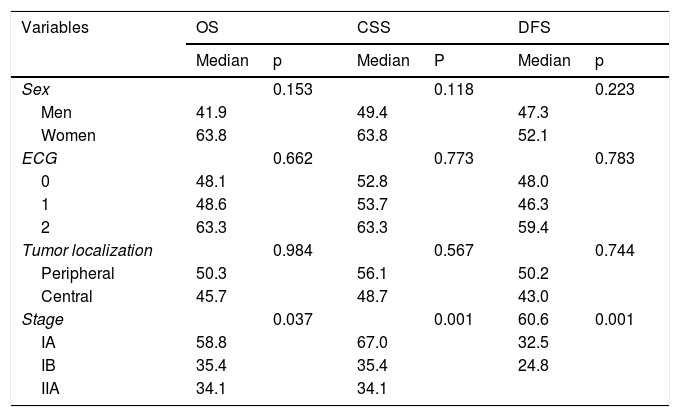To assess the utility of [18F]FDG PET/CT quantitative parameters as prognostic factor in patients diagnosed with localized and inoperable lung cancer treated by stereotactic body radiotherapy (SBRT).
Material and methods50 patients (42 men) diagnosed in the last 7 years with early-stage lung cancer and treated with SBRT alone were assessed by a prospective study. After PET/CT study, metabolic parameters maximum SUV (SUVmax), metabolic tumor volume (MTV) and total lesion glycolysis (TLG) were determined at different thresholds. The prognostic factors for overall survival (OS), cause-specific survival (CS) and disease-free survival (DFS) were analysed by Cox proportional hazards model and the survival analysis by Kaplan-Meier method.
ResultsThe average follow-up was 39.6 months, with 21 recurrences and 24 dead. Univariate analysis determined MTV30 and MTV40 as predictors for OS; MTV30, MTV40, TLG30 and TLG40 for CS and MTV2, MTV30, MTV40, TLG2, TLG30 and TLG40 for DFS. Survival analysis found statistically significant differences for CS and DFS depending on tumor size and for DFS considering the cut-off values of MTV2 and TLG2 (threshold SUVmax = 2). SUVmax, age and sex were not shown to be significant factors.
ConclusionPre-treatment quantitative assessment using metabolic parameters MTV2 and TLG2 as well as tumor size proved to be prognostic factors in patients diagnosed with localized and inoperable lung cancer treated by SBRT. Results could help to personalize treatment.
Evaluar la utilidad de parámetros cuantitativos de la PET/TC con [18F]FDG como factores pronósticos en pacientes diagnosticados de cáncer de pulmón localizado e inoperable, tratado únicamente mediante radioterapia estereotáxica corporal (SBRT).
Material y métodosSe valoraron mediante estudio prospectivo 50 pacientes (42 hombres) diagnosticados en los últimos 7 años de neoplasia pulmonar en estadios precoces y tratados únicamente mediante SBRT. Tras realización del estudio PET/TC, se determinaron los parámetros metabólicos SUV máximo (SUVmax), volumen metabólico tumoral (MTV) y glicolisis tumoral total (TLG) a diferentes umbrales. Se analizaron los factores pronósticos para la supervivencia global (SG), supervivencia por causa específica (SCE) y supervivencia libre de enfermedad (SLE) mediante regresión de Cox y las curvas de supervivencia mediante el método de Kaplan-Meier.
ResultadosEl seguimiento medio fue de 39,6 meses, produciéndose 21 recurrencias y 24 exitus. El análisis determinó como factores predictivos MTV30 y MTV40 para la SG; MTV30, MTV40, TLG30 y TLG40 para la SCE; y MTV2, MTV30, MTV40, TLG2, TLG30 y TLG40 para la SLE. El análisis de supervivencia halló diferencias estadísticamente significativas para la SCE y la SLE dependiendo del tamaño tumoral y para la SLE dependiendo de los valores de MTV2 y TLG2 (umbral de SUVmax = 2). El SUVmax, la edad y el sexo no fueron factores significativos.
ConclusiónLa valoración cuantitativa pretratamiento mediante los parámetros metabólicos MTV2 y TLG2, así como el tamaño tumoral demostraron ser factores pronósticos en pacientes con neoplasia pulmonar localizada e inoperable tratados mediante SBRT. Los resultados podrían ayudar a personalizar el tratamiento.
Article

Revista Española de Medicina Nuclear e Imagen Molecular (English Edition)














